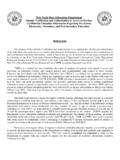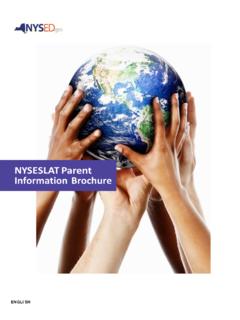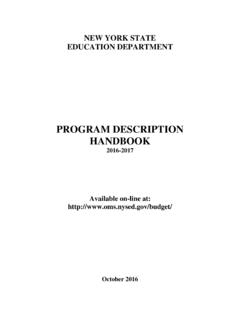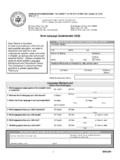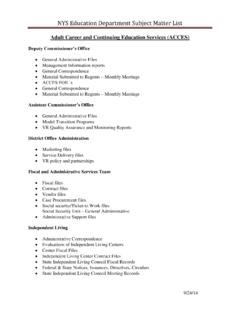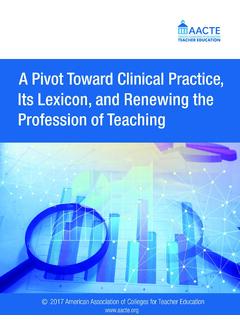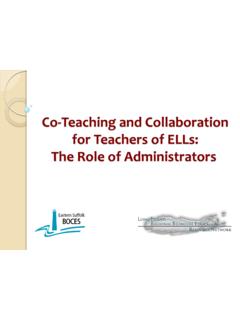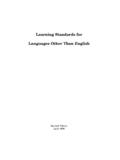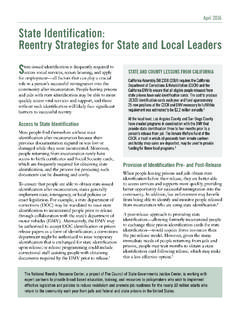Transcription of Questions and Answers - New York State Education …
1 Students with Interrupted/Inconsistent Formal Education (SIFE). Questions and Answers General Information Identification and Placement Curriculum THE State Education DEPARTMENT / THE UNIVERSITY OF THE State OF NEW york / ALBANY, NY 12234. Office of P-12. Lissette Col n-Collins, Assistant Commissioner Office of Bilingual Education and World Languages 55 Hanson Place, Room 594 89 Washington Avenue, Room 528EB. Brooklyn, New york 11217 Albany, New york 12234. Tel: (718) 722-2445 / Fax: (718) 722-2459 (518) 474-8775/ Fax: (518)474-7948. THE UNIVERSITY OF THE State OF NEW york . Regents of the University BETTY A. ROSA, Chancellor, , in Ed., in Ed., , .. Bronx T. ANDREW BROWN, Vice Chancellor, , .. Rochester JAMES R. TALLON, JR., , .. Binghamton ROGER TILLES, , .. Great Neck LESTER W. YOUNG, JR., , , .. Beechhurst CHRISTINE D. CEA, , , .. Staten Island WADE S. NORWOOD, .. Rochester KATHLEEN M. CASHIN, , , .. Brooklyn JAMES E. COTTRELL, , .. New york JOSEPHINE VICTORIA FINN, , .. Monticello JUDITH CHIN, in Ed.
2 Little Neck BEVERLY L. OUDERKIRK, in Ed., in Ed.. Morristown CATHERINE COLLINS, , , , in Ed., .. Buffalo JUDITH JOHNSON, , , .. New Hempstead NAN EILEEN MEAD, .. Manhattan ELIZABETH S. HAKANSON, , , .. Syracuse LUIS O. REYES, , , .. New york Commissioner of Education and President of the University MARY ELLEN ELIA. Executive Deputy Commissioner ELIZABETH R. BERLIN. Senior Deputy Commissioner for Education Policy JHONE EBERT. Deputy Commissioner of Instructional Support ANGELICA INFANTE-GREEN. The New york State Education Department wishes to thank the NYS Board of Regents, the SIFE Workgroup, and many others who helped with the development of identification instruments to serve Students with Interrupted/Inconsistent Formal Education (SIFE). Special thanks to The Regional Bilingual Education Resource Network; Rachel Hoff;. NYCDOE; Wanda Ortiz-Rivera, Brentwood UFSD; Judy Goris-Moroff, Huntington; Rejane Ribeiro and Sharon Deland, Patchogue-Medford; Cecilia Blanco, South Huntington; Maria Fielteau, Utica; Tiara Reyes Vega, Yonkers; The BRIDGEs Program staff; Elaine Klein; Annie Smith; Suzanna McNamara; Aika Swai; and many others.
3 The State Education Department does not discriminate on the basis of age, color, religion, creed, disability, marital status, veteran status, national origin, race, gender, genetic predisposition or carrier status, or sexual orientation in its educational programs, services and activities. Portions of this publication can be made available in a variety of formats, including braille, large print or audio tape, upon request. Inquiries concerning this policy of nondiscrimination should be directed to the Department's Office for Diversity and Access, Room 530, Education Building, Albany, NY 12234. INTRODUCTION. In an effort to support school districts throughout New york State to improve the identification and the provision of instructional services for Students with Interrupted/Inconsistent Formal Education (SIFE), the Office of Bilingual Education and World Languages (OBEWL) is launching a collection of tools, including a Multilingual Literacy Screener (MLS). We believe that meeting the needs of SIFE is a considerable challenge, however, when students are properly identified and provided with the appropriate supports and opportunities they can strive to meet and surpass grade level standards.
4 Additional Questions ? Please send Questions or comments to the Office of Bilingual Education and World Languages CR Part 154/SIFE Q&A. A. GENERAL INFORMATION. Q: What is the definition of SIFE in New york State ? Under the new CR Part 154, a Student with Inconsistent/Interrupted Formal Education shall mean English Language Learners (ELLs) who have attended schools in the United states (the 50 states and the District of Columbia) for less than twelve months and who, upon initial enrollment in such schools, are two or more years below grade level in literacy in their home language and/or two or more years below grade level in Math due to inconsistent or interrupted schooling prior to arrival in the United states (the 50. states and the District of Columbia) [ (y)]. The definition above is inclusive of Low Literacy SIFE, students who have literacy at or below third grade in their home language. This means that they are not yet fluent readers in any language and do not independently use text as a resource to build new knowledge.
5 Q: What does it mean to be two grade levels below the entering grade? For example, a student entering ninth grade is not expected to have home language literacy in ninth grade since they are just starting in that grade, so we would expect an entering 9th grader to have 8th grade literacy in home language. Therefore, home language literacy at 6th grade or below (not 7th) would make this student a SIFE. Q: What is the SIFE population in New york State ? The SIFE population for the 2014-2015 school year is of the total ELL population. Q: What are the SIFE New york State Top Spoken Languages in 2014-2015? Spanish Arabic Chinese Haitian Creole Bengali Karen French Burmese Q: Why is there a different category for SIFE? As their instruction has been interrupted, inconsistent, and sometimes unavailable, SIFE. may have complex social and psychological needs due to possible traumatic migration experiences, frustrations with their academic delays in relation to their peers, a lack of familiarity with school culture, and feelings of isolation in school.
6 Some may not possess the academic knowledge demonstrated by their peers who have consistently attended school. Schools are often unequipped to meet the complex needs of SIFE. As one of the 1. most vulnerable, at risk sub-groups of students, this population requires a commitment from all stakeholders to develop innovative approaches in order to appropriately serve them. Q: What has changed for SIFE under the new CR Part 154 regulations? If the student is identified as an ELL, and the Home Language Questionnaire (HLQ). indicates that the student has attended school in the United states (the 50 states and the District of Columbia) for less than twelve months and is two or more years below grade level in literacy in their home language and/or math due to inconsistent or interrupted schooling prior to arrival in the United states (the 50 states and the District of Columbia), the student shall also be identified as a Student with Inconsistent/Interrupted Formal Education . [CR Section (y)].
7 B. IDENTIFICATION AND PLACEMENT. Q: What are the identification steps for SIFE? Schools in NYS should adhere to the following procedures: Administer the Home Language Questionnaire (HLQ). Conduct an individual interview Administer the New york State Identification Test for English Language Learners (NYSITELL). For more information on the identification process visit: If the student was identified as an ELL and was found to be a potential SIFE during the administration of the HLQ and the individual interview, then the SIFE Oral Interview Questionnaire, the Multilingual Literacy SIFE Screener (MLS), and the Writing Screener should be administered. All SIFE materials can be found here: Q: What led to the creation of new resources for SIFE identification? Previously, SIFE identification and placement methods varied across NYS; therefore, NYS. schools and districts were utilizing an array of different methods to identify SIFE. Some schools and districts had no systems in place to identify and serve SIFE.
8 Others had protocols to identify and serve SIFE, but relied upon the discretion of individual schools to implement them. In addition, most available protocols for SIFE identification were translated into Spanish and not into other languages. NYSED has developed the following tools to help identify and serve SIFE including: The Oral Interview Questionnaire and Guidance, a Writing Screener and the SIFE Curriculum. 2. Q: Should educators assume that speakers of indigenous languages have oral or written proficiency in the dominant language of their country of origin? No. For example, a Fula speaker from Guinea might not have oral language or literacy in French even though French is the official language. This is the same with a Quechua speaker in Spanish speaking country or a Garifuna speaker in some Central American countries. Q: Will the home language of SIFE be reported to the State , and will there be a standard tool (rubric) for determining their literacy level? Yes, the home language should be captured for all ELLs via the Student Information Repository System (SIRS).
9 If the student is found to be a potential SIFE, according to CR. Part 154 section (y), the SIFE Oral Interview Questionnaire should be administered, followed by the Multilingual Literacy Screener (MLS) to ascertain for SIFE. home language literacy level. Q: Can a student be identified as a SIFE before the ELL classification? No. A district should follow the protocol established in the CR Part 154 Regulations Chart for the identification of ELLs and then follow procedures for the identification of SIFE. Q: Can SIFE be identified at any point in the semester, not just at enrollment? Yes, as long as it follows the appropriate prescribed guidelines in the Part 154. Regulations, which establish that the process for initial enrollment or reentry identification and parent notification, orientation, and placement shall be completed such that a student is placed in either a Bilingual Education or an English as a New Language program within ten (10) school days after the student's initial enrollment or reentry in the school district.
10 [ (g)(1)]. Q: What are some challenges that SIFE may encounter that not all ELLs face? ELLs are assumed to have literacy and academic background knowledge at or close to grade level. Services for ELLs are targeted to support language acquisition. SIFE might face additional hurdles: In addition to learning English. SIFE often have not been exposed to the content knowledge that provides a foundation for participation in secondary school. They also do not have the home language literacy level of many secondary students. Instruction for SIFE must build language, literacy, and content knowledge. While the majority of non-SIFE ELLs have already learned to read in their first language and have also learned to use reading strategies, SIFE use rudimentary strategies to navigate their environment even though some have not yet learned to read print. Non-SIFE ELLs have acquired academic background knowledge that 3. allows them to transfer this information to English, while SIFE have not had the opportunity to develop this knowledge.

